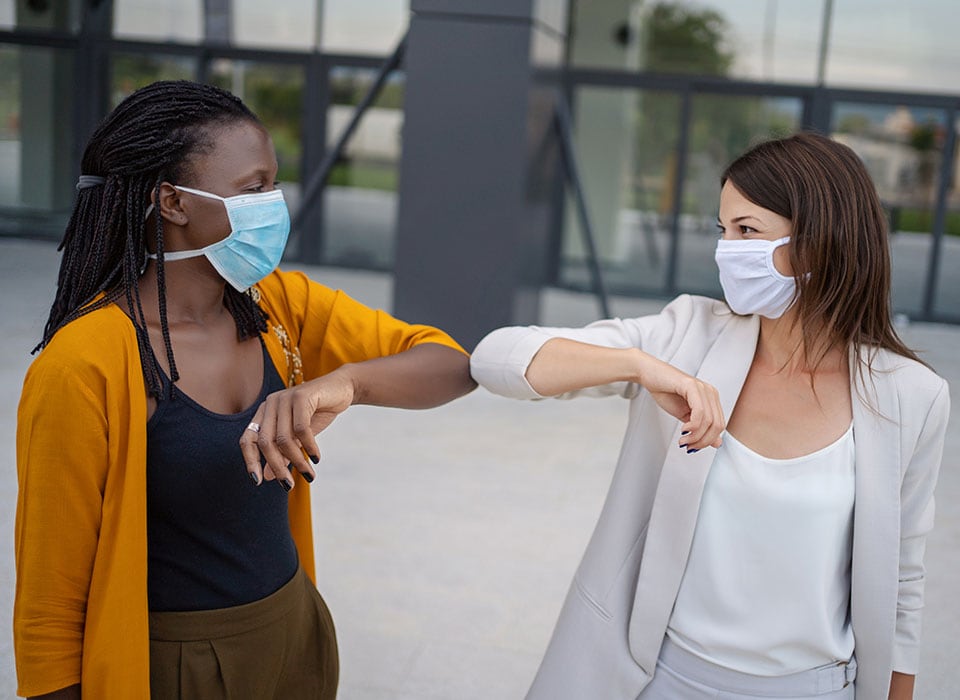The last year has taught us a lot.
Today, we now have the crucial knowledge of how to make whipped coffee, how to dress for a Zoom meeting (nice shirt on top, comfy sweatpants on bottom), and which stores have the best curbside pickup.
More importantly though, we’ve witnessed the strength of human resiliency, heard breathtaking tales of human courage, and learned vital vocabulary and techniques to help us and our loved ones remain healthy.
Yes, the following words have expanded our Scrabble skills, but they are also lessons we can take with us into the future. Hopefully the next pandemic isn’t occurring anytime soon, but cold and flu season is always right around the corner. Now equipped with infectious disease tools and terminology, we can keep ourselves and our communities safe from more than just COVID-19.
Viral vocab
Social distancing
Social distancing is the practice of reducing contact between large groups of people. Being social creatures, the cancelling of concerts, sporting events, and festivals is difficult but necessary to help reduce the spread of an infectious disease.
If you must go out and about, the CDC recommends keeping a distance of at least 6 feet between you and other people.
PPE
PPE is an acronym standing for “personal protective equipment.”
Personal protective equipment includes masks, clothing, goggles, helmets, face shields, or anything that can be worn to minimize the risk of injury, or in the COVID-19 pandemic’s case, the spread of infectious disease.
Just like your wallet, keys, and phone, face masks have become an essential item when leaving your house. Like many infectious diseases, COVID-19 is mainly spread through droplets and air particles. While a mask does protect you some, it is more designed to reduce the number of droplets and particles leaving your mouth and nose, therefore protecting the people around you.
Flatten the curve
Flattening the curve refers to slowing the spread of an infectious disease so that the hospital systems do not become overrun and overwhelmed with patients.
There isn’t an infinite supply of doctors and nurses, and if they get sick, or are too busy or too fatigued, patients who are in critical need of medical care may not receive it.
The curve refers to a graph of infections. A flatter curve means infections aren’t increasing as quickly.
It is important for the healthy population to do everything they can to help the medical practitioners by slowing the spread of infectious diseases.
Quarantine vs. isolation
The terms quarantine and isolation can be confusing, but there is one key difference between the two terms.
People in quarantine are not necessarily sick but have been in contact with an infected person. The act of quarantining is to help stop the spread of an infectious disease by making sure that people who may not be showing symptoms yet do not unknowingly spread the disease.
Isolation on the other hand is the act of separating people who are actively infected with a disease from people who are healthy.
Viral inoculum
Viral inoculum is the amount of virus that one is exposed to prior to becoming infected. Research has shown that the lower the initial exposure to a virus such as COVID-19 is, the less serious the illness tends to be, and vice-versa.
Community spread
The undetected spread of an infectious disease throughout a neighborhood, city, state, or country is called community spread.
The initial source of the disease is often unknown, and the illness is spread by seemingly healthy people.
Epidemic vs. pandemic
The difference between an epidemic and a pandemic has to do with the scale of the spreading disease.
An epidemic is the spreading of an infectious disease within one region or country.
A pandemic is the spreading of an infectious disease that affects a large portion of the global population over a wide geographical area.
Pod
A pod or quarantine pod is a small group of people who interact socially only with one another, usually without social-distancing or wearing a mask. For example, a household of four roommates who interact solely with one another without masks is considered a quarantine pod.
Contact tracing
When a person is known to be infected, other people who have been around the infected individual are located. Known as contact tracing, the people who have been around the infected individual are then placed in quarantine or isolation (if they are ill).
Respirator vs. ventilator
A respirator is a mask device that covers the nose and mouth and has special filters to help prevent the wearer from inhaling any harmful toxins or virus particles. This type of mask is often worn by carpenters and house painters, but it should not be worn by the general public to help stop the spread of COVID-19. The valves on these masks are designed to filter out toxins when breathing in, not when breathing out. So while this mask would protect you from virus particles, you could be unknowingly breathing out droplets that contain the virus.
A ventilator is a machine that helps patients breathe. A tube is inserted into the patient’s windpipe, and oxygen is pumped into the patient’s lungs. These machines are only used within hospitals and are often a last resort measure when fighting COVID-19.

